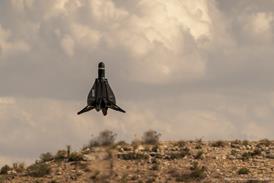Ramon Lopez/WASHINGTON DC

Northrop Grumman is beginning to look at developments of its RQ-4A Global Hawk high-altitude, long-endurance unmanned air vehicle that could include stealth features for the airframe and payloads that would allow it to perform nearly 20 more operational roles.
Plans are also being developed to deploy Global Hawk to Australia to test its compatibility with surveillance systems there.
The first stage of the US/Australian joint programme was the signing of a government-to-government research and development agreement last month.
"Stage 2 is a combined effort to develop, integrate and test new payload and ground element capabilities suited to the Australian operational environment," says Col Craig McPherson, the US Air Force programme director.
During Stage 2, the USAF is responsible for project and technical management of modifications to the integrated sensor suite and for planning the Stage 3 non-stop deployment flight to Australia. The second stage is under way and runs to January 2001.
Australia is creating a concept of operations for the demonstration and is providing funds and technical expertise to develop maritime surveillance and integrated ground segment capabilities. Australia contributed $600,000 to the first stage and has allocated $10 million to Stage 2.
The USAF will provide up to $10 million for Stage 3. McPherson says the joint exercises will highlight Global Hawk's long range and improve its maritime surveillance capabilities.
The USAF will decide next September whether the Global Hawk advanced concept technology demonstration will move to a year-long engineering and manufacturing development programme.
McPherson says at least 40 RQ-4As will be built to carry the baseline electro-optical/infrared sensor and synthetic aperture radar payload. Nineteen other uses are being reviewed, however, including signals intelligence and airborne communications.
Northrop Grumman can produce up to 10 Global Hawks a year and hopes to supply at least 100 to the USAF. Germany, Israel, Sweden and the UK are among the countries also expressing an interest in the UAV.
A Block 10 Global Hawk with greater payload capabilities is already envisaged. Giving the UAV stealth features "is something Northrop Grumman is going to be looking at", says a company official. This would allow Global Hawk to replace the cancelled Lockheed Martin/Boeing DarkStar.
Four of the five RQ-4As built by Northrop Grumman's Ryan Aeronautical Center are still flying and negotiations continue for a further two.
On 6 December, Global Hawk No 3 suffered minor damage after its nose gear collapsed when it veered off a runway at Edwards AFB. The cause of the incident is being investigated.
Source: Flight International























